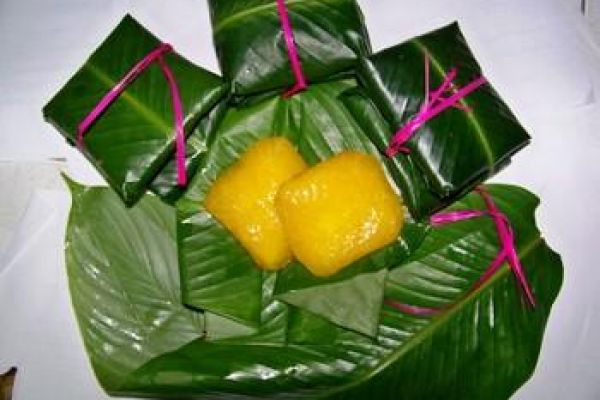
The skin of the cake is made by grinding and filtering large-sized grain glutinous rice to retrieve the starch. The starch of this rice will be mixed with scraped green papaya and soaked in the juice of the fruit of cape jasmine, which makes the skin both crispy and glutinous and gives it a light yellow color. The stuffing is made of green bean ground with sugar, sugar coated lotus seeds and coconut meat. After stuffed, the cake is wrapped into a square shape in leaves from phrinium and coconut trees and boiled in hot water.
The whole cake is made by hand and each household in the village has their own secret recipe passed down through generations, creating their own tastes and brands for the cake.

Phu The Cake
It is said that the kings of the Ly Dynasty encouraged agricultural expansion and in their period Dinh Bang and other villages in the country had bumper crops. During the Lunar New Year and festivals, the locals of Dinh Bang used these agricultural products to make a cake named su se to make offerings to the ancestors. Once, King Ly Thanh Tong (1023 – 1072) and his wife Y Lan visited the village for a festival and had a chance to taste this cake. They complimented this cake, renamed it to phu the cake and asked the villagers to make it for wedding ceremonies to celebrate the happiness of the couple.
After the cakes are boiled they are wrapped in green banana leaves and tied in pairs with bamboo strings dyed in pink, as an icon of the loyalty of the love between husband and wife.
Vietnamese people know about the cake in the whole country now, and the Cake is made all year round in the markets of the village. In some areas it is wrapped in a square box of banana leaves to offer as a gift.
Source: vietnamcharm
(84-63) 3 826042 – (84-63) 3 511142
No 54 Nguyen Dinh Chieu, Ham Tien Central Mui Ne Beach Binh Thuan Vietnam
523 To Hien Thanh District 10 Ho Chi Minh City Vietnam
Ha Long Halong City Quang Ninh Vietnam
A13 Hung Thong 2 Halong City Quang Ninh Vietnam




